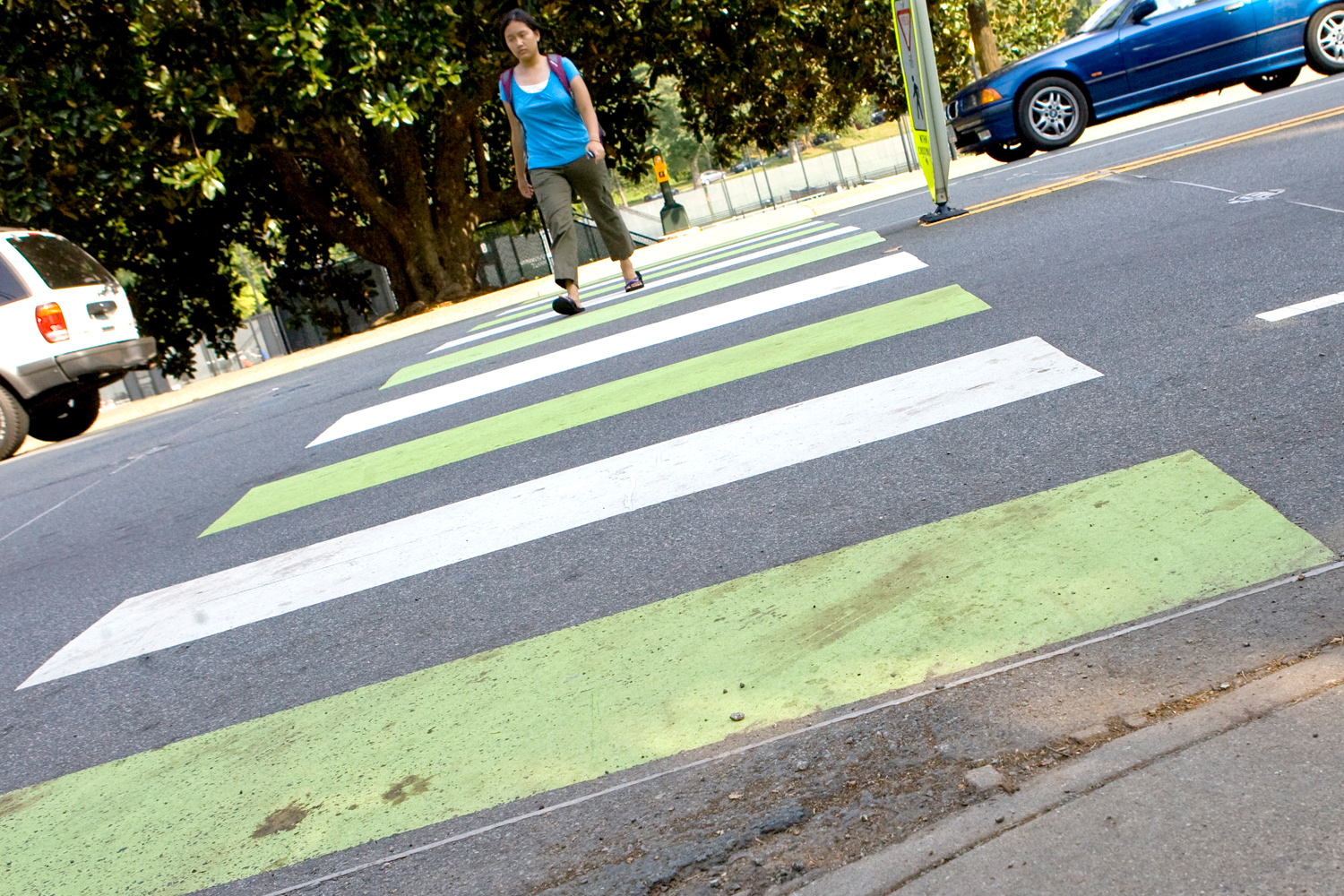September 12, 2008 — One way to keep pedestrians safe is to light the way for them.
The University of Virginia has installed seven crosswalks with light-emitting diodes — flashing lights in the street that illuminate the crosswalk paths and warn approaching drivers. The first was installed last spring across Emmet Street at its intersection with Sprigg Lane, a crossing used heavily by the students at the International Residential College.
Brad Brown, principal on the college, said collisions between pedestrians and cars used to happen at least once a year.
"It varied from a bump to a broken leg or a concussion," he said. "We tried things such as improving the lighting on the street, but this is really effective. We haven't had anyone hit since they were installed."
Mark Fletcher, chairman of the University's Safety and Security Committee and executive director of Intramural and Recreational Sports, said students had asked for help. The lights, he said, are simple but effective.
"On a dark night, when the rain is coming down, they will be really valuable," he said.
Before entering the street, pedestrians push a button to activate the lights. All the crosswalks are button-activated except the one at the Medical Center, which is footpad-activated.
"The safety concern here is to get people's attention at the crosswalks," said Leonard T. "Spike" Weeks, the University's project manager for the installations. "These lights work well 24-7."
After the first crosswalk proved effective, six more were installed. The additional lighted crosswalks are at the intersection of University Avenue and Culbreth Road, the intersection of Alderman Road and Tree House Drive, across Emmet Street at the Central Grounds Garage, across Emmet Street at the Kerchof Hall steps, across Jefferson Park Avenue at the Health Sciences Library and across Lee Street by the Medical Center's East Parking Garage.
"Every location has been well-thought-out," Weeks said. "These are places that have a lot of traffic."
The City of Charlottesville also has plans to install six LED crosswalks in high-traffic areas.
"We are trying to make the downtown area more pedestrian-friendly," said Donovan Branche, assistant traffic engineer for the city. "A lot of people are happy with the safety and the visibility."
The University has no plans to add more lighted crosswalks and the city will limit itself to six for now. Weeks said too many lit crosswalks would dilute their effectiveness.
A similar system was installed between the University Hall parking lot and Klockner Stadium several years ago, but the lights were damaged by a snowplow. Weeks said the lights of the new system are mounted nearly flush to the road surface and will not be damaged by plows or traffic.
Weeks was skeptical when that first crosswalk was installed, but became a believer once he saw it in action.
"They make perfect sense," he said. "The lights go all across the street and are visible at high noon or midnight. Now I am proud that we have them in."
The University of Virginia has installed seven crosswalks with light-emitting diodes — flashing lights in the street that illuminate the crosswalk paths and warn approaching drivers. The first was installed last spring across Emmet Street at its intersection with Sprigg Lane, a crossing used heavily by the students at the International Residential College.
Brad Brown, principal on the college, said collisions between pedestrians and cars used to happen at least once a year.
"It varied from a bump to a broken leg or a concussion," he said. "We tried things such as improving the lighting on the street, but this is really effective. We haven't had anyone hit since they were installed."
Mark Fletcher, chairman of the University's Safety and Security Committee and executive director of Intramural and Recreational Sports, said students had asked for help. The lights, he said, are simple but effective.
"On a dark night, when the rain is coming down, they will be really valuable," he said.
Before entering the street, pedestrians push a button to activate the lights. All the crosswalks are button-activated except the one at the Medical Center, which is footpad-activated.
"The safety concern here is to get people's attention at the crosswalks," said Leonard T. "Spike" Weeks, the University's project manager for the installations. "These lights work well 24-7."
After the first crosswalk proved effective, six more were installed. The additional lighted crosswalks are at the intersection of University Avenue and Culbreth Road, the intersection of Alderman Road and Tree House Drive, across Emmet Street at the Central Grounds Garage, across Emmet Street at the Kerchof Hall steps, across Jefferson Park Avenue at the Health Sciences Library and across Lee Street by the Medical Center's East Parking Garage.
"Every location has been well-thought-out," Weeks said. "These are places that have a lot of traffic."
The City of Charlottesville also has plans to install six LED crosswalks in high-traffic areas.
"We are trying to make the downtown area more pedestrian-friendly," said Donovan Branche, assistant traffic engineer for the city. "A lot of people are happy with the safety and the visibility."
The University has no plans to add more lighted crosswalks and the city will limit itself to six for now. Weeks said too many lit crosswalks would dilute their effectiveness.
A similar system was installed between the University Hall parking lot and Klockner Stadium several years ago, but the lights were damaged by a snowplow. Weeks said the lights of the new system are mounted nearly flush to the road surface and will not be damaged by plows or traffic.
Weeks was skeptical when that first crosswalk was installed, but became a believer once he saw it in action.
"They make perfect sense," he said. "The lights go all across the street and are visible at high noon or midnight. Now I am proud that we have them in."
— By Matt Kelly
Media Contact
Article Information
September 12, 2008
/content/university-virginia-installs-lighted-crosswalks-increase-pedestrian-safety

